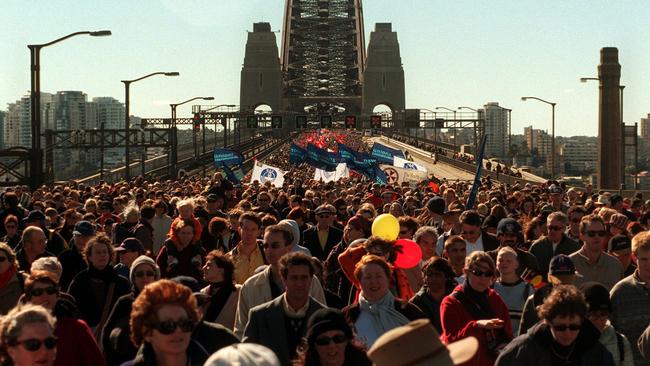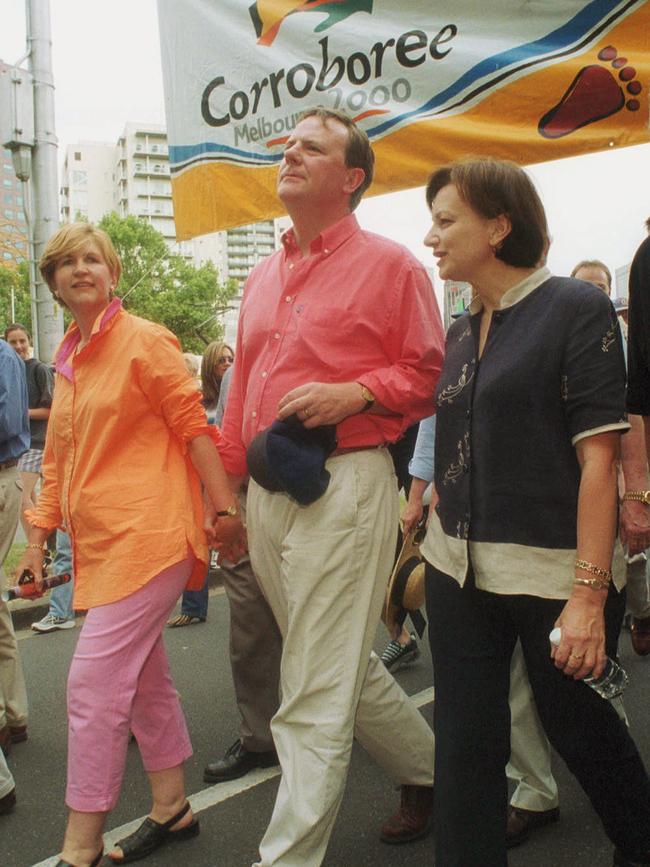Cabinet archives: Indigenous bridge too far for some ministers
The Howard cabinet was divided over whether ministers should join the walk for reconciliation over the Sydney Harbour Bridge in May 2000.

The Howard cabinet was divided over whether ministers should join the walk for reconciliation over the Sydney Harbour Bridge in May 2000, but then treasurer Peter Costello was adamant that ministers should participate as a gesture of goodwill towards Indigenous Australians.
“I argued that we should walk across the bridge,” Mr Costello told The Weekend Australian. “(John) Howard’s argument was it looked bad if some ministers went on the walk and others didn’t, and I said, ‘Well why don’t we all walk?’”
“It was my view that it would be a lovely symbolic gesture if a group of us just walked across the bridge, but the balance of opinion was that since some wouldn’t walk, no one should — and I accepted that.”
Mr Costello did participate in the Melbourne reconciliation bridge walk later that year.
Looking back, the former treasurer and deputy Liberal leader accepted it was “just symbolic” but argued it would have done no “damage” to the government.
“Sometimes a little bit of symbolism can help,” he said.
Cabinet papers released by the National Archives of Australia document differences between ministers on Indigenous affairs and reconciliation through 2000.
The Council for Aboriginal Reconciliation’s Document Towards Reconciliation — to be launched at Corroboree 2000 at the Sydney Opera House before the bridge walk — was debated extensively. Cabinet ministers instead adopted their “preferred” version, which emphasised “practical as well as appropriate symbolic reconciliation”.
In accordance with the priority given to “practical reconciliation”, cabinet agreed to a proposal by then minister for Aboriginal and Torres Strait Islander Affairs John Herron to fund an additional 1000 participant places in remote and regional areas under the Community Development Employment Projects scheme, costing $47m over four years.
But it was well short of the 6000 places requested by Mr Herron, who was alarmed by Indigenous unemployment.
While the Department of Prime Minister and Cabinet backed the submission, the Treasury was opposed as they doubted the CDEP was “the best way to improve the situation”. John Anderson, who was deputy prime minister at the time, was frustrated with initiatives he felt had little do with improving the lives of Indigenous Australians.

“I care very deeply about Aboriginal people, but I had become convinced that much of the symbolism had become an excuse, frankly, for a refusal to sit down and re-establish Aboriginal agency,” he told The Weekend Australian. “The key to this, more than anything else, is re-establishing a true sense of agency and responsibility, and facilitating people to use it wisely and properly. I felt discussions were dominated by people who thought they knew what Aboriginal people needed when they bloody well did not.”
When the Northern Territory and Western Australia introduced mandatory sentencing laws directed at Indigenous Australians, the Howard government decided not to use constitutional powers to “override” the laws.
But Mr Howard did raise his “concern about the practical impact on juveniles”, and the Northern Territory legislation was amended to recognise only 18-year-olds as adults and that diverting juveniles to treatment programs rather than facing charges was required. Additional funding of $5m was provided to the Northern Territory as part of this agreement.
When the UN began investigating mandatory sentencing, concerned about the impact on human rights, the cabinet took umbrage and directed the then minister for foreign affairs, Alexander Downer, to write to the UN secretary-general to convey the government’s “concern” about not being informed in advance.
John Howard told The Weekend Australian that, on principle, he did not think prime ministers should join marches but was not “hostile” towards reconciliation.
“There were some differences on some of those symbolic things like taking part in marches,” he said. “I don’t recall there being any fundamental differences on policy though.”




To join the conversation, please log in. Don't have an account? Register
Join the conversation, you are commenting as Logout